Who Controls the User Experience? AMD’s Carrizo Thoroughly Tested
by Ian Cutress on February 4, 2016 8:00 AM ESTBenchmark Results: Web and Synthetic
Here are our results from our web and synthetic tests. A reminder of our systems:
| System Overview | |||||
| µArch | APU | Base / Turbo MHz |
Memory | Channel | |
| HP Elitebook 745 G2 | Kaveri | A10 PRO-7350B (19W) | 2100 / 3300 | 8 GB | Dual |
| HP Elitebook 745 G3 | Carrizo | PRO A12-8800B (15W) | 2100 / 3400 | 4 GB | Single |
| Toshiba Satellite E45DW-C4210 |
Carrizo | FX-8800P (15W) | 2100 / 3400 | 8 GB | Single |
| HP Pavilion 17z-g100 |
Carrizo | A10-8700P (15W) | 1800 / 3200 | 8 GB | Single |
| Lenovo Y700 | Carrizo | FX-8800P (15W) | 2100 / 3400 | 16 GB | Single |
Google Octane 2.0
Lots of factors go into web development, including the tools used and the browser those tools play in. One of the common and widely used benchmarks to judge performance is Google Octane, now in version 2.0. To quote: 'The updated Octane 2.0 benchmark includes four new tests to measure new aspects of JavaScript performance, including garbage collection / compiler latency and asm.js-style JavaScript performance.' We run the test six times and take an average of the scores.
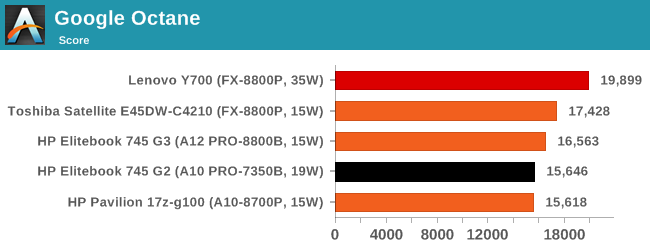
Octane splits hairs between the Kaveri and A10-8700P, but the Toshiba has the higher skin temperature and can turbo for longer than the Elitebook G3.
Mozilla Kraken 1.1
Kraken is a similar tool to Google, focusing on web tools and processing power. Kraken's tools include searching algorithms, audio processing, image filtering, flexible database parsing, and cryptographic routines.
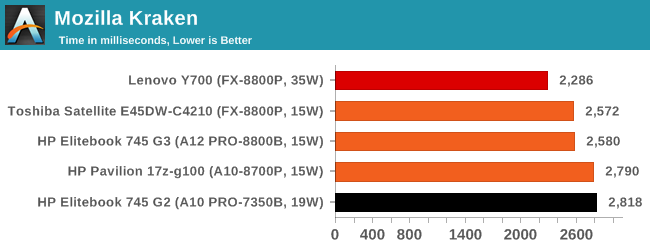
Kraken mirrors Octane, except this time the A10-8700P gets a jump on the Kaveri.
WebXPRT 2013/2015
WebXPRT aims to be a souped up version of Octane and Kraken, using these tools in real time to display data in photograph enhancement, sorting, stock options, local storage manipulation, graphical enterfaces and even filtering algorithms on scientific datasets. We run the 2013 and 2015 versions of the benchmark.
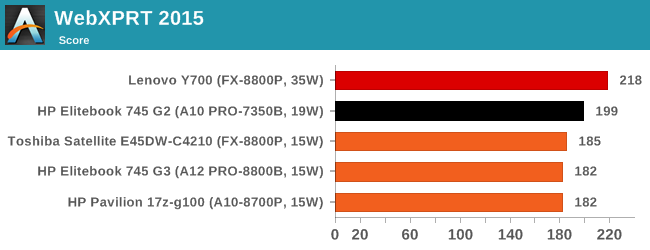
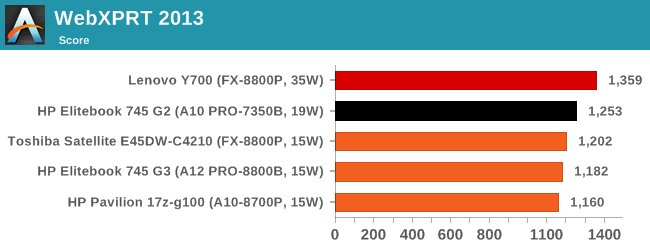
In both versions of the benchmark, the Kaveri system beats all the 15W Carrizo platforms. It was inevitable that at some point during the benchmarking that those extra four watts of thermal headroom in the chip might allow the CPU to turbo for longer – as WebXPRT is by nature a bursty workload, if it can use this to its advantage then we’ll surely see a regression.
I want to pull out some power numbers a little early here to show what I mean. Here are the two Elitebooks in WebXPRT 2013, whose scores differ by 6%:
These power numbers were taken under the ‘all else equal rule’, so each screen was at the same brightness and almost zero applications requesting run time in the background. Here we see that the Carrizo system is drawing less power on average in idle and load (a common theme), but suffers from higher peak power draw and a much larger average-to-idle change in power (which can be overshadowed by onboard components coming out of sleep). It means we get the very uneasy metric of 1208.7 J of energy consumed for the Kaveri over idle and 1932.8 J of energy consumed for Carrizo, though it does depend on how much idle is truly idle across the whole SoC and platform.
This might be where the performance deficit lies though – in a Carrizo system that boasts lower power at idle and lower power draw on average, in a bursty workload environment it is actually wasting time and power to switch things on and off constantly.
Cinebench 15/11.5
Cinebench is a widely known benchmarking tool for measuring performance relative to MAXON's animation software Cinema 4D. Cinebench has been optimized over a decade and focuses on purely CPU horsepower, meaning if there is a discrepancy in pure throughput characteristics, Cinebench is likely to show that discrepancy. Arguably other software doesn't make use of all the tools available, so the real world relevance might purely be academic, but given our large database of data for Cinebench it seems difficult to ignore a small five minute test. We run the modern version 15 in this test, as well as the older 11.5 due to our back data.
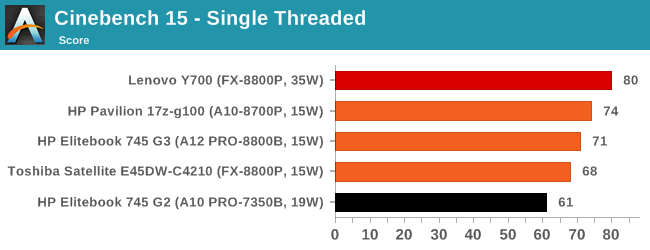

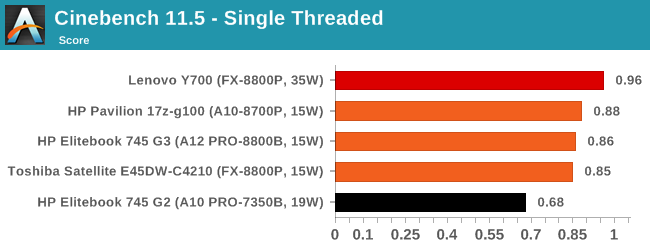
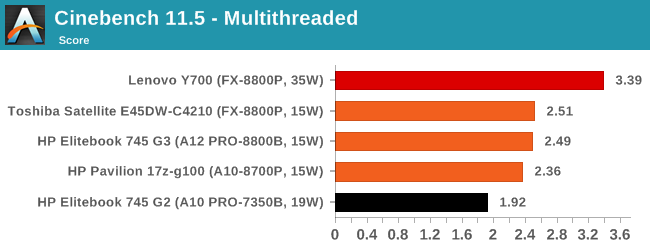
Cinebench shows the spread of performance relating to the microarchitecture advantages of Carrizo compared to Kaveri, as well as the benefits that a 35W part can give over a 15W part. That being said, this spread of results, while perhaps an academic answer to ‘which is the fastest’ is not often seen in the real world.
x264 HD 3.0
The x264 HD 3.0 package we use here is also kept for historic regressional data. The latest version is 5.0.1, and encodes a 1080p video clip into a high quality x264 file. Version 3.0 only performs the same test on a 720p file, and in most circumstances hits its limit on high end processors, but still works well for mainstream and low-end. Also, this version only takes a few minutes, whereas the latest can take over 90 minutes to run.
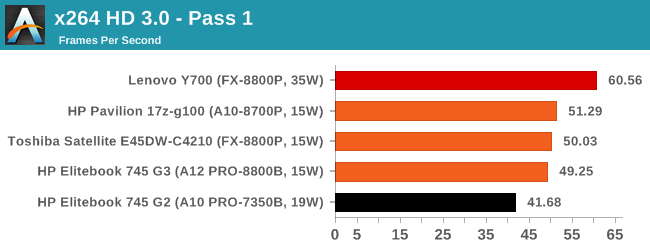
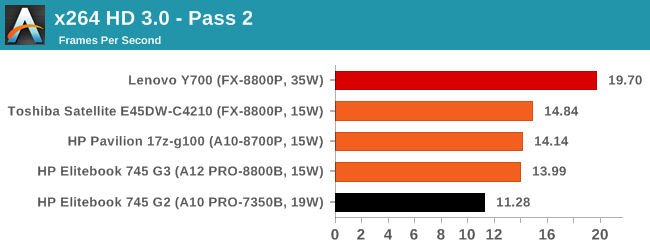
As with Cinebench, we get an ideal academic spread of data.






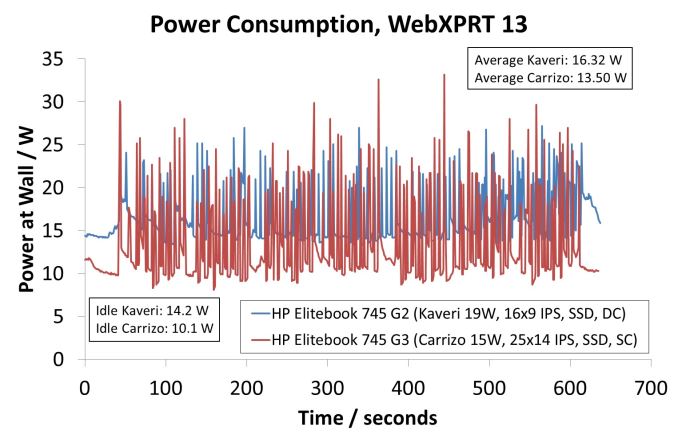








175 Comments
View All Comments
chris471 - Friday, February 5, 2016 - link
What do you do with all those split hares? Are they any good barbecued?("Octane splits hares between the Kaveri ...")
Ian Cutress - Friday, February 5, 2016 - link
Lightly roasted for me :) Edited, thanks!maglito - Friday, February 5, 2016 - link
Were you able to test 18Gbps HDMI? The ability to drive an external display with 2160p 4:2:2 @ 60Hz? I guess the lack of a 10bit accelerated video decoder almost makes the point moot for future 2160p content though....Otherwise, fantastic article!
MonkeyPaw - Friday, February 5, 2016 - link
Last time I shopped for a laptop (which was recently), I was considering an A10-based HP with a 1080p screen. The problem I saw was in reviews the battery life was really poor. It looked like HP put a small battery in it, making the thing only worthy as a DTR. I ended up going with a Lenovo with an i3. I guess part of the problem is that there are so many variants of laptops that finding a review of a specific model is impossible, and all you have to go on are things like Amazon or Best Buy ussr reviews, which can be extremely painful to read.Lolimaster - Friday, February 5, 2016 - link
HP sometimes release near "nice" AMD laptops but always cripples it with laughable battery capacities, same models intel inside dont get the nerfs.euskalzabe - Friday, February 5, 2016 - link
That was a wonderful article that I thoroughly enjoyed reading to start my Friday. Long story short, you perfectly define my laptop buying rationale with "SSD, dual channel memory, 8 hours+ light battery, under 2kg, Full HD IPS panel".That's why I bought an i5 UX305. I wanted an AMD machine because I plain like the company and would like them to succeed to bring more competition to Intel, but I found NOTHING even close to the specs you mentioned. The UX305 fit the description perfectly and cost me $750. It was an immediate purchase for me. If AMD managed the OEM relationship to create such a machine, it would be an insta-buy for me. Also, Zenbooks with Zen APUs oculd be a great marketing strategy :)
Shadowmaster625 - Friday, February 5, 2016 - link
AMD is a company that shoots itself in the foot at every opportunity. I am truly perplexed. Their cat cores shouldnt even exist. But not only do those crippled parts exist, they crippled their premium parts by combining the two platforms! WHY? How could they not see that every notebook would be single channel? They wasted the entirety of their ATI purchase, as you can see with the Rocket League results vs Intel. This is a disgrace.AMD needs to realize that it IS AMD who controls the User experience. Look at the Mackbook Air. Look at the Surface Pro. Look at the Playstation 4 and Xbox One. All of these platforms have a set minimum level of performance. Sure they might be more expensive than a $300 atom clunker, but at least the user will not throw the thing out the window after pulling their hair out.
AMD needs to put a floor under their products. 4 cores. 8GB of unified HBM. 512 cores GPU. This is the SoC that they need. Sure they can fuse off a core or whatever to harvest bad dies, but this is the minimum die they should be making. Ideally within 2 years they will move to a 4 core, 16GB HBM, and they will replace one stack of HBM with 128GB of HBF. They need to control the memory bandwidth of their SoC. Take away the ability of the OEMs to cripple performance. Use HBF to take away the ability for OEMs to cripple storage performance also. Do this, and every AMD system will be fast. And it will get design wins.
t.s - Friday, February 5, 2016 - link
If you read the article: AMD not crippled their premium parts. It was OEM. If only OEM create mobos that have dual channel mems.xthetenth - Friday, February 5, 2016 - link
OEMs shaving pennies is as universal a phenomenon as gravity, and designs should be made as such.t.s - Thursday, February 11, 2016 - link
hence the title, "who controls user experience" :)